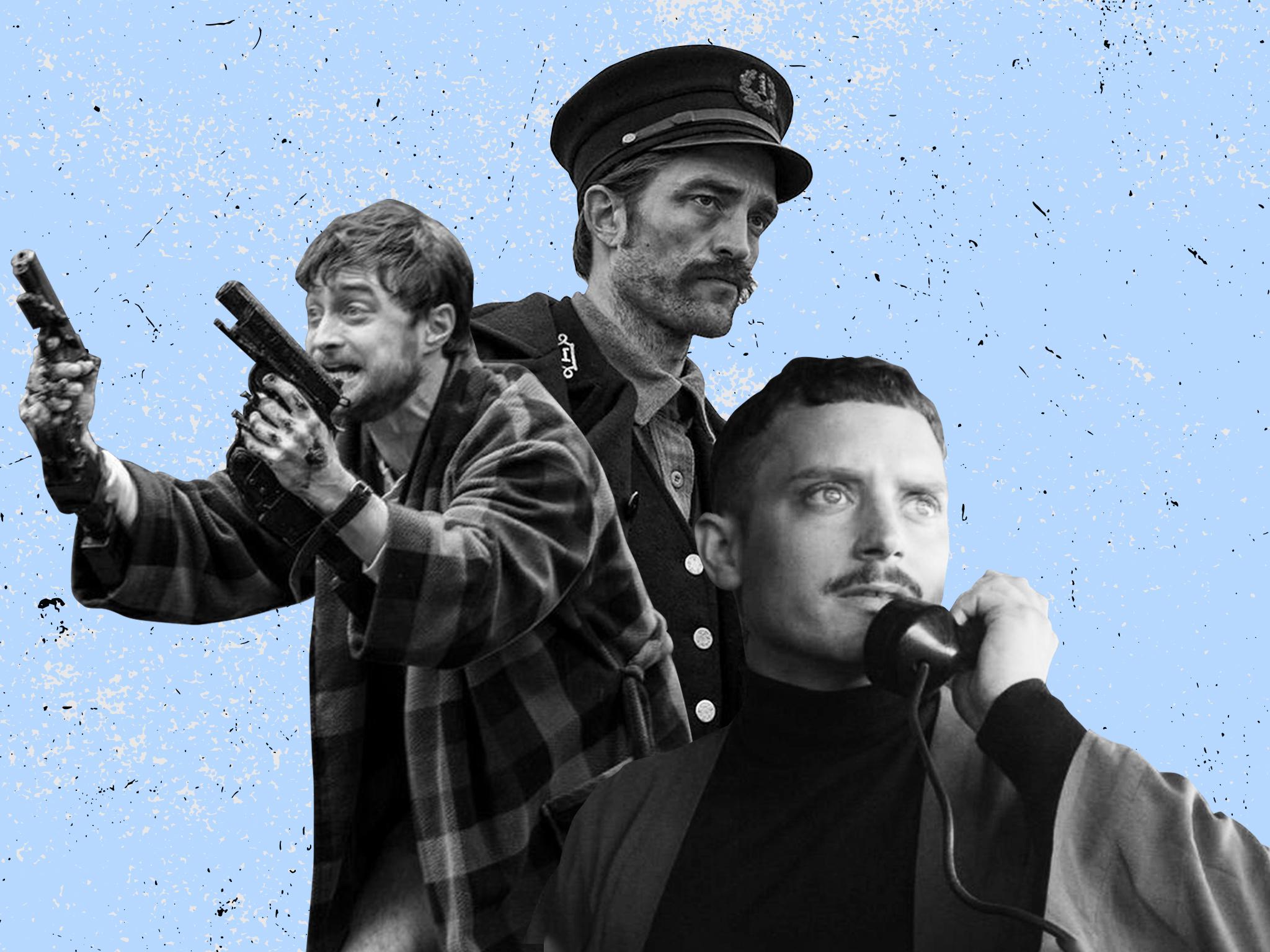Pretty boys gone bad: How Robert Pattinson and Daniel Radcliffe found cinematic salvation in the weird and wonderful
From the hallucinatory gibberish of ‘The Lighthouse’ to the wholesome farting corpse comedy that is ‘Swiss Army Man’, these actors went all-out in order to achieve the impossible, writes Clarisse Loughrey


Somewhere behind that lion’s mane of hair, wiry beard, and thick South African accent lies Daniel Radcliffe. In Escape from Pretoria, he’s thrown himself so deep into the role of an anti-apartheid activist planning a daring prison escape that he’s practically unrecognisable. Guns Akimbo, released later this year, will see him run around in a bathrobe and huge slippers designed to look like tiger feet, with two guns bolted to his hands. Any memory of the boy wizard he once was has officially been left for dust.
All actors struggle to free themselves from the gluttonous jaws of typecasting, but for a former child star swept up in a major franchise to have done it? That’s like defeating Goliath blindfolded and with your hands tied behind your back. And yet, while Radcliffe’s career so far has been impressive, it’s not exactly unique. In the early Noughties, Hollywood was gripped by an enthusiasm for fantasy franchises, where pretty much every male lead was scrawny and pale-faced. Elijah Wood slipped on a pair of hobbit feet to play Frodo Baggins in the Lord of the Rings trilogy, while Robert Pattinson co-starred with Radcliffe in the Goblet of Fire before taking on the role of Twilight’s sparkly, sentimental bloodsucker Edward Cullen. Suddenly, the biggest films in the world were being fronted by actors who didn’t boast the same broad appeal of a, say, Brad Pitt or Keanu Reeves.
What do you do after playing a teen vampire, wizard, or hairy-footed halfling? For Radcliffe, Wood, and Pattinson, it meant blowing their public image sky-high. It took each of them a few attempts, but all three eventually settled into a new, weird, and experimental groove. Radcliffe went grimy, Wood went blood-splattered, and Pattinson… well, anyone who’s seen The Lighthouse will agree he’s gone all-out bats*** crazy. It was a dilemma that Mark Hamill also faced post-Luke Skywalker. The actor didn’t have the rough-and-ready machismo that allowed Harrison Ford to jump from Star Wars to Indiana Jones to Blade Runner and so on. He was stuck as a squeaky clean teen idol who was tailor-made for sitcom appearances and not much else. It was only when he stepped back from the camera and towards the recording booth that he found a second wind, carving a separate (and now almost equally venerated) career as a voice actor – the man behind the animated Joker and Chucky from last year’s Child’s Play reboot.
Radcliffe didn’t even wait until the end of the Potter series to start distancing himself from it. Months before the release of Order of the Phoenix in July 2007, the actor hit the boards with a starring role in Peter Shaffer’s Equus, about a teenage boy with an erotic fixation on horses. Since the role involves onstage nudity, the production instantly became the focus of controversy – reports started to circulate that Radcliffe had been booted out of the Potter franchise in response. Undeterred, he spent the months before Deathly Hallows – Part 2 in a Broadway revival of How to Succeed in Business Without Really Trying. It’s a fairly clean-cut musical (a sex comedy only in the 1960s sense), but the actor’s bouncy American accent and corporate fervour still felt miles away from the world of wands and cauldrons.
It was harder to replicate that distance on film. His take on beat poet Allen Ginsberg in 2013’s Kill Your Darlings was suitably quiet and introspective, but the film failed to gain much attention. That same year, he starred in both a romcom (The F Word) and a horror (Horns). His mainstream films bordered on disastrous: both 2015’s Victor Frankenstein and 2016’s Now You See Me Two, a film about magicians who pull heists, were nonsense cash-ins that did little to separate Radcliffe from his Potter past. But then came Swiss Army Man, released slightly later in 2016, in which the actor was called upon to play a farting corpse. Directed by Daniel Kwan and Daniel Scheinert, the film sees Paul Dano play a man marooned on an island who finds an odd companionship with a bloated, washed-up body. The film’s outrageous, but sincere; it was an instant Sundance hit. Radcliffe, too, proved that he could find emotional nuance in a role that required lying perfectly still and not moving a muscle. Swiss Army Man opened the door to a surprising career shift that since seen him largely play sweaty and desperate men. Alongside Escape from Pretoria and Guns Akimbo, he played Amazonian explorer Yossi Ghinsberg in 2017’s Jungle and a drug smuggler in 2018’s Beast of Burden. It’s an angle that’s particularly suited for him – the actor has a quiet intensity to him, but without the posturing masculinity. He’s got a clear talent for playing the everyman placed in an extraordinary situation.
Elijah Wood’s career suffered many of the same bumps. But it, too, eventually found its stride. He was already well-established as a former child star when he was cast as Frodo, with roles in Back to the Future Part II, Flipper, and Deep Impact. But the moment Peter Jackson’s trilogy ended in 2003, he tried to make audiences fear those bright blue peepers. Over the next two years, he played a creep in Eternal Sunshine of the Spotless Mind, a serial killer in Sin City, a football hooligan in Green Street. But the effort to flip his image on its head felt too deliberate. No one quite bought the transformation. And so, he slipped back to more conventional fare. In 2006, he starred in the animated caper Happy Feet and Bobby, an ensemble drama about the assassination of Robert F Kennedy.
The pivotal moment came in 2010, when he co-founded The Woodshed, a horror production company. It rebranded as SpectreVision in 2013. It’s since allowed him to become a major, and often unappreciated figure, in today’s horror landscape. His work as a producer includes A Girl Walks Home Alone at Night, The Boy, The Greasy Strangler, Mandy, and Color Out of Space. Plus, he’s still landed a few choice roles for himself, including 2012’s grisly Maniac remake and this year’s Come to Daddy.
Robert Pattinson, admittedly, has had an easier ride. He shifted from the mildly broody Cedric Diggory to the extremely broody Edward Cullen and then on to every different shade of broodiness there is. Cast as the sappy romantic lead in both 2010’s Remember Me and 2011’s Water for Elephants, he was given a new lease of life by director David Cronenberg – and the gates to the world of prestige cinema were suddenly flung open. Since starring in Cronenberg’s Cosmopolis (2012), about a young billionaire set on a path of self-destruction, he’s worked with David Michod, Werner Herzog, Brady Corbet, James Gray, the Safdie Brothers, and Claire Denis. Each successive role has seen him shed the aloof mystique of his Twilight years in favour of something more bug-eyed and feral, with its peak being all the gibberish-spouting, furiously masturbating hysteria of The Lighthouse, released last month in UK cinemas.
His next few steps see him inch back towards the mainstream. He’ll star in another of Christopher Nolan’s time-twisting thrillers, Tenet, and take the lead role in Matt Reeves’s The Batman. But there’s been such a dramatic remoulding of his image that the story here is more about the artsy weirdo taking on conventional work, rather than a former vampire playing pop culture’s other kind type of bat fetishist.
The roles that made these men famous freed them and constrained them in equal measure. Yes, they’ve had to work to put distance between themselves and these cyclopean franchises, but someone is always going to want the credit for placing Harry Potter or Frodo Baggins in a new light. A studio will be more willing to pump money into a creative risk such as Swiss Army Man when they know the project’s being headlined by such a familiar face. There must be some small amount of comfort to be gained in knowing you’ve earned your place in celluloid history in the first few years of your career.
But there’s a certain amount of male privilege attached to that freedom. It’s illuminating to compare the careers of Pattinson and Radcliffe to their female co-stars. Emma Watson’s remained largely in the mainstream, continuing the kind of prim and proper roles (take Beauty and the Beast or Little Women, for example) that seem like a natural extension of Hermione Granger. The exception here is Sofia Coppola’s The Bling Ring from 2013 – her turn as a light-fingered brat is still the best of her career. What if she’d been allowed to wander further out of the box? Kristen Stewart, meanwhile, has worked with her fair share of auteurs like Olivier Assayas and Kelly Reichardt. She’s delivered astounding performances in Personal Shopper, Certain Women, and Clouds of Sils Maria (she was the first American actor to win at France’s prestigious Cesar Awards), but these roles have never seen her play dramatically against type enough to convert those who still cling to the idea of her as sullen, awkward, and mumbling. Stewart and Watson haven’t been able to radically experiment with their public image because those roles so rarely exist for women. And, as the careers of Radcliffe, Wood, and Pattinson have shown, audiences have always been stuck in their ways. Only the boldest choices will change their minds.
Escape from Pretoria is released in UK cinemas on 6 March
Join our commenting forum
Join thought-provoking conversations, follow other Independent readers and see their replies
Comments